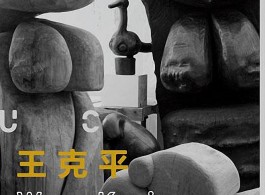News release
Radical ‘Stars’ artist Wang Keping exploded onto the Chinese art scene in the late 1970s as the leader of a contemporary art group. He now returns to Beijing to present the largest exhibition of his work ever shown in the country to date.
The Ullens Center for Contemporary Art is proud to present “Wang Keping” an exhibition of more than 50 works by one of China’s first contemporary sculptors. The show contains sculptures from various moments in the artist’s 35-year career and covers a wide range of different subjects and themes.
Wang Keping (b. 1949, Beijing) is an artist of near-monomaniacal dedication to his chosen medium: wood. Wang’s artworks range in size from 30 cm to several meters tall, variously evoking grotesque deformity, sensual beauty, and sublime abstraction. The artist’s seemingly anachronistic, lyrical sculpture cuts an intriguing figure in an art world dominated by increasingly complex and reflexive systems of meaning and signification. His works are evocative of Constantin Brâncusi’s Modernist explorations, Han Dynasty funereal figures, and African fertility sculptures, though their warped formal abstractions and embrace of eroticism place them squarely into a class of their own.
Wang Keping started out making political sculpture as part of the charged environment of late 1970s Beijing. After moving to France in 1984, he shifted to a more naturalistic way of working. The artist’s work can be roughly divided into five thematic categories—men, women, birds, couples, and pure forms—into which they are grouped for the UCCA exhibition.
Wang Keping’s practice evinces a patience beyond that of virtually any artist practicing today. To prepare the wood for his sculptures, he will let logs sit for months, sometimes years, allowing the innate features and fissures of the material to grow and deepen until they take on their own distinctive, biologically-determined shapes. Wang’s decades of woodworking experience allows him some measure of foresight into how the wood will splinter, though every piece contains an element of chance. For each sculpture, Wang blends his aesthetic perspective with the form determined by the wood itself, a quasi-Modernist Michelangelo living in the age of contemporary art. As Wang has said, “The wood tells me something, gives me an idea. Each tree is like a human body: there is flesh and there is bone; there are tender parts, hard parts, solid parts, and fragile parts. You cannot go against its nature but must follow it.”
The artist is remarkably consistent, even to the point of defiance. Wang Keping’s defiant streak first emerged in the late 1970s, as a founding member of one of China’s first experimental art groups, The Stars. Alongside fellow members Huang Rui, Ma Desheng, and Ai Weiwei, Wang fervently championed artistic freedom in China. Though he has lived abroad for nearly 30 years, his defiant streak persists, now articulated as aesthetic rather than political rebellion: He is an outspoken critic of the French art establishment and of the contemporary art scene as a whole, insistent that his sculptural practice is a more honest and sincere artistic expression than those which blindly follow new trends.
Wang Keping also bucks the current trend of delegating artistic production to studio assistants, completing his sculptures entirely on his own. As the artist has put it, “Making a sculpture is like making love to a woman. No one can do it for you, nor would I want others to take my place.” From the initial collection of the wood, to the carving, firing, burnishing, and glazing of each piece, Wang exerts total control over his artworks, a craftsman of obsessive dedication.
Despite distancing himself from the mainstream art establishment, the artist sees no contradiction between his style and the spirit of contemporary art. Of his work, Wang has said, “In my sculpture, I strive to find that which is universal in primitive Chinese form, and the further back I go to the origins of this art, the closer I am to my idea of contemporary art.”
Wang Keping was born in Beijing in 1949 and has lived in Paris since 1984. He is a founding member of The Stars (Xing Xing), often called the first avant-garde contemporary art movement in China. Wang is primarily a sculptor of wood and is inspired by the figurative form, both female and male. He strives towards simplicity, creating symbols of human nature and sensuality. His work has been exhibited widely around the world, including in the Centre Georges Pompidou, Musée Maillol, and Musée Zadkine in France; in the Kunstmuseum Bern in Switzerland; in the Brooklyn Museum in the US; and in the National Art Museum of China and He Xiangning Art Museum in China. His work has been acquired by several important international art institutions, including the Fonds Municipal d’Art Contemporain, Paris; Olympic Games Park, Seoul; National Taiwan Museum of Fine Arts, Taizhong; M+ museum, Hong Kong; Musée Cernuschi, Paris; and Ashmolean Museum, Oxford.




